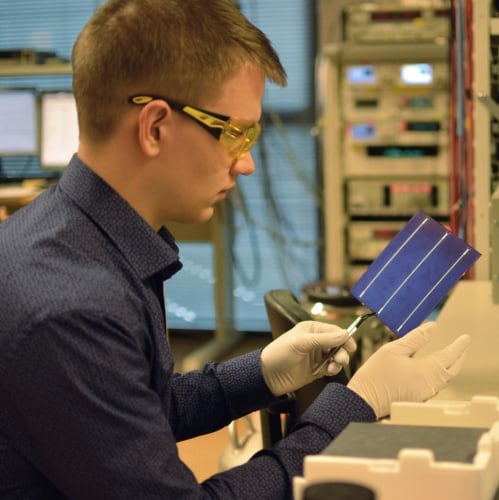Engineers at Michigan Technological University have found that applying an atomic level coating to "black silicon" dramatically reduces the production costs of solar cells. Black silicon is the name given to the material when it has been treated by a dry etching process to create a surface texture resembling a forest of nanoscale needles.

Conventionally, solar cells appear blue because of a surface treatment designed to improve the amount of light they absorb. This treatment is applied to both perfect silicon crystal cells and multi-crystalline silicon which is slightly cheaper. However, the reflection of light, even with the wavelength shift, indicates that not all the light is captured by the cells. Joshua Pearce, professor of materials science and electrical engineering at MTU, is investigating black silicon, whose surface captures much more light and therefore appears to not reflect at all, and attempting to discover whether it could be a feasible large-scale replacement for the current types of surface-treated silicon.
Black silicon is so nonreflective that it is "like looking into the eyes of Darth Vader," Pearce commented. However, it is not often used because the dry etching process, although creates a high surface area, also leads to a great many surface defects which were thought to affect electrical performance. Pearce and his team, collaborating with the Department of Electronics and Nano Engineering at Aalto University in Finland, where Pearce was working on sabbatical, experimented with adding an atomic layer deposition (ALD) coating on top of the dry etched nanosurface. This, they explain in an article in the journal Energies, mitigates the effect of the surface defects.
Previously, it had been thought that combining dry etching with ALD would make solar cells too expensive for commercial use. "Margins are extremely tight. Everyone's trying to push costs as low as possible," Pearce said. And indeed, individual cells were between 15.8 and 25.1per cent more expensive than conventional cells. However, the efficiency gains and the ability to switch from perfect crystals to poly-crystalline silicon outweighed those extra costs, and overall the cost per unit power fell by 10.8. per cent.
While the spot price for solar cells may change day by day - or even by hour - the results still hold. "That's 10 percent decline between cell types from whatever the number is that day," Pearce said. This is because the comparisons were made on relative costs, not absolute costs. That's also why arbitrarily fluctuating tariffs were not factored into the calculations.
According to the researchers, the process could still be optimised for further cost per unit power cuts. This, Pearce suggested, could help to greatly accelerate photovoltaic cell manufacture. The European Union, which currently makes a lot of the manufacturing equipment, should also "look carefully at scaling up deep reactive ion etching and ALD tools to meet the needs of the rapidly expanding PV market.” he said.




Red Bull makes hydrogen fuel cell play with AVL
Formula 1 is an anachronistic anomaly where its only cutting edge is in engine development. The rules prohibit any real innovation and there would be...